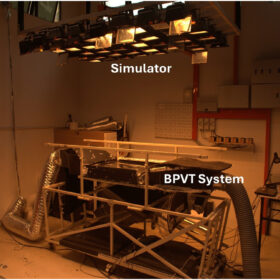Scientists testing perovskite-silicon tandem solar cells with interdigitated back contacts
A research team in Iran has designed a four-terminal perovskite-silicon tandem solar cells with a 19.3%-efficient bottom heterojunction cell and a 12.7%-efficient perovskite top cell. Both subcells were conceived to have interdigitated back contacts, with the top cell reportedly helping to improve the tandem device’s light-trapping and efficiency.
Scientists design concentrating PV system equipped with cooling, waste heat recovery tech
Scientists in Iran have designed a CPV system that integrates a paraffin-based nanomaterials cooling system with fin, as well as thermoelectric generators that turns wast heat into electricity. Simulated results demonstrated that, with the cooling system in place, the PV efficiency improves by approximately 16.46% in clean conditions.
New model to generate high-resolution annual solar energy potential maps
Researchers in Iran have used digital elevation models to improve the accuracy of solar energy potential maps. Their model is intended to identify the best areas for solar panel deployment in urban areas.
Digital twin for autonomous aerial monitoring of PV power plants
An international research team has created a digital twin that purportedly enables analysis of different scenarios on PV plants’ aerial monitoring. The new tool is claimed to reduce the risk associated with real-world experimentation and help identify the most effective strategies to improve PV system monitoring.
Cooling bifacial PV thermal solar panels with jet impingement
Scientists created a model to study bifacial PV thermal (BPVT) solar panels using jet impingement and built an experimental setup to validate it. They achieved a thermal efficiency of 62.28%, while electrical efficiency peaked at 11.22%.
Fraunhofer ISE, TMU build ‘aquavoltaic’ system for microalgae production
The system can reportedly reduce electricity costs in aquaculture. It consists of an open raceway pond, a mechanical paddle wheel, a motor and power transmission system, a motor speed control circuit, a 100 W photovoltaic module, and 12-V battery with a capacity of 60 Ah, an inverter, and a 10-A charge controller.
Standalone PV-hydrogen-battery system for EV charging
Researchers in Pakistan have tested several configurations of an offgrid PV-hydrogen system intended to power EV chargers. The system achieved the lowest levelized cost of electricity when it was combined with battery storage.
Photovoltaics for hydroponic greenhouses
Researchers in Iran have investigated the operation of a real solar-powered greenhouse in the Alborz province and have found that only 4% of the greenhouse’s roof needs to be covered with PV modules to meet demand for lighting and pumping water.
Improving perovskite solar cell performance with conductive adhesive ink
Conceived by researchers from Iran, the new conductive adhesive ink is made of polymethyl methacrylate (PMMA) and is used as an interlayer between the cell’s hole transport layer and carbon foil. It reportedly ensures higher cell stability while also providing remarkable efficiency.
Solar-assisted heat pumps vs. air-source heat pumps
A group of researchers in Iran has analyzed the coefficient of performance and the energy consumption of a solar-assisted heat pumps and an air-source heat pumps and has found that three factors are crucial to determine their annual performance – irradiance changes, ambient temperature, and wind speed.










